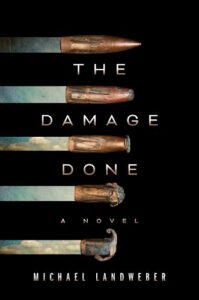This is the story of two novels, both written by me, one unpublished and one that just came out this month. The first, the one in the drawer, was a very violent tale about people who are able to regenerate. The second, a direct reaction to the first, is about a world where violence is no longer possible. But the real story here is how writing these two books led me to reconsider my own approach to writing violence in fiction, and to think more broadly about both readers’ and writers’ expectations around violence generally.
I have always been a little squeamish. I nearly failed biology in college due to an inability to dissect a frog. And I’ve never gravitated toward the more violent entertainment options. I missed a number of sleepovers as a kid when I realized that Friday the 13th or similar viewing options were on the table. With books, I also tended away from horror and excessive gore. I remember getting nauseous and lightheaded on the train in Tokyo trying to push through a particularly descriptive scene in Anne Rice’s Interview with the Vampire. Similarly, Stephen King’s story, The Raft, made me reconsider my life choices, particularly when one of the characters gets pulled slowly, in excruciating detail, through the tiny space between two wooden boards.
Despite all this, I have never shied away from violence in my own work. I do not believe that there should be no violence in entertainment. Just the opposite. Violence is one of the few things that, unfortunately, is common in every culture, every civilization, every country, every community throughout human existence. A writer cannot ignore violence. There are many genres and stories that don’t require it, but just as many where its absence would be unrealistic. For readers, a violent scene can be both cathartic and devastating. Reading and watching violence in novels and movies allows us to face our worst fears and survive them. It can be escapist. It can be thought-provoking. Giddy screams and desperate tears are both legitimate reactions to violence on screen and on the page, depending on the treatment. But violence can also be excessive and gratuitous, unnecessary and cliché. The hard part as writers is knowing the difference.
In my unpublished book, a minority population that is able to regenerate is discriminated against by the society at large. Regeneration is not a new concept – hello, Deadpool – but my characters were not superheroes despite being able to heal quickly and regrow body parts. Instead, they were forced into dangerous jobs and denied basic rights. Some of them sold their bodies, not for sex, but for violence. The very concept leant itself to descriptions of a very graphic nature. I wrote it that way, even though that is not how I normally approach even the most violent moments in my other writing. And it didn’t work.
So why did I do it? Later, I realized that I had given in to the expectations of the concept. As writers, we know there is no such thing as an original idea. But every telling of a story is unique. Give twenty writers the same prompt and you’ll get twenty different – usually startlingly so – stories. But at the same time, writing a novel is a delicate dance between meeting the reader’s expectations and confounding them. I would argue that the hardest expectations to shake are those involving violence.
Characters are expected to seek revenge for their murdered child or sibling or spouse. Serial killers are expected to kill their victim in unique and horrifying ways. Thrillers are expected to end with a bloody all-out fight between the protagonist and antagonist. Of course, there are countless ways to avoid cliches in these sub-genres, but there is always a certain inevitability about the arc of violence. This is not specific to certain genres either. In literary fiction, we’ve all read the intergenerational family sagas where the domestic abuse or wartime atrocities feel as inevitable as the killer in any thriller.
Once I started thinking about the expectation of violence in my writing and other writers’ work, I got the idea for my current novel, The Damage Done. In the book, people are suddenly and inexplicably unable to commit any act of violence. Besides thinking it was a cool premise, I wanted to push myself away from the expectations that had led to the problems in my previous novel. The book is told from the perspective of seven main characters who all experience violence in their daily lives. And I put them in situations where the expectation of the reader would be that such violence is unavoidable. A drunk abusive husband returning home to his wife. A middle school boy run down by a pack of bullies. A teenager looking for his brother’s killer. A refugee fleeing gangs in her country. A dissident writer in a dictator’s notorious prison. And in each case, I wrote two stories, one in my head and one on the page, the first the expectation of what would happen in the real world and the second that happened in the world without violence. The characters navigate the changed world in surprising ways even as those who wish to hurt them try to scheme around the new rules. That was one expectation I did not avoid – even if violence is impossible, people will still try to find a way to hurt each other.
As long as there is violence in the world, there will be violence in literature and entertainment. But next time I write a scene with any kind of violence, I will ask myself how it would play out in a world without violence. It is something worth considering in every time we write and read about violence. Maybe that is one small way to overcome our expectations, our innate biases, about just how violent the world must be.
***


















